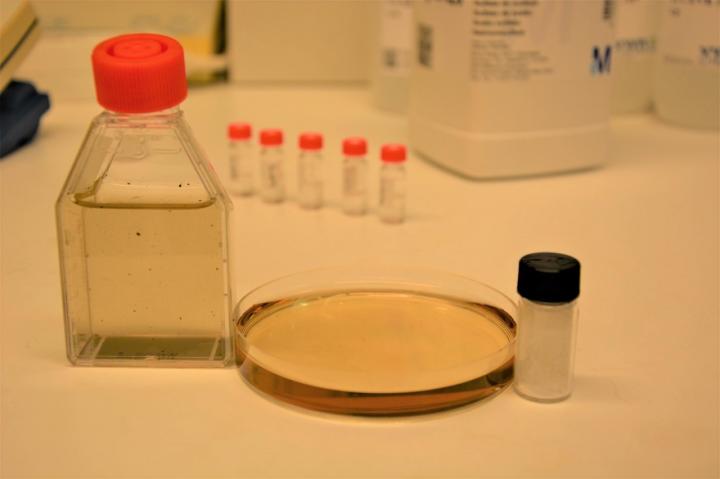Microbes from humics lakes produced omega-3 fatty acids from microplastics

Plastic carbon was transformed even to beneficial fatty acids, omega-3 and omega-6, by the microbes originating from humic lakes. Credit: The University of Jyväskylä
Increasing abundance of plastic waste has alarmed the society, but the environmental fate of microplastics has been difficult to trace. A research group led by the University of Jyväskylä used carbon isotope labelling to follow the fate of polyethylene in the food chain.
For the surprise of the researchers, plastic carbon was transformed even to beneficial fatty acids, omega-3 and omega-6, by the microbes originating from humic lakes. The research was published in Scientific Reports -series at the end of December 2019.
In the recently published study, Dr. Sami Taipale and his co-workers studied biodegradation of polyethylene, which is one of the most used plastics. Polyethylene was labelled with 13C-isotope, which enables the most sensitive technology for studying the fate of slowly degrading materials.
“We analyzed produced gases and microbial fatty acids using stable isotope mass spectrometry”, says Taipale, who just received a 4-year project from Kone Foundation to continue his studies on microplastic degradation.
“We wanted to study whether microbes that have the ability to decompose complex humic compounds would also use recalcitrant microplastic polymers, continues Taipale. -And indeed, microplastic degradation was more pronounced by microbes originating from the humic lakes than from the clear water lakes.
“Fatty acids profiles also helped to identify the bacterial groups that were responsible for the decomposition”, says the co-author, professor Marja Tiirola, who leads a new Academy of Finland project for discovering decomposers of recalcitrant materials.
“The lack of labelled material limits the microplastic studies, so we welcome partners to synthesize other labelled plastic types.”
Showing direct utilization of polyethylene carbon and its upgrading in the upper food chain is a methodological breakthrough. The method was sensitive enough to show that microplastic carbon was incorporated into essential fatty acids, omega-3 and omega-6, of flagellated eukaryotic species. In the further study, these essential fatty acids supported the growth and became integrated to the cell membranes of herbivorous zooplankton, next level in the aquatic food chain.
Previous studies have suggested that high concentrations of microplastics can inhibit the growth of algae and zooplankton. However, this study showed that growth-inhibition observed in high polyethylene concentrations (30 mg L-1) was fully neutralized by microbial decomposers.
“The plastic surface was covered by microbes, which utilized released chemicals or prevented physical contact to algae and zooplankton”, says one of the co-authors professor Jussi Kukkonen specialized in ecotoxicology. Since microbes can cease the potential toxicity of microplastics in aquatic environments, ecorealistic testing should be performed in the presence of natural microbiomes.
###
Link to the article published in Scientific Reports 27th of December 2019: https:/
For further information:
Senior lecturer Sami Taipale, sami.taipale@jyu.fi, +358 40 805 4121
Professor Marja Tiirola, mtiirola@jyu.fi, +358 44 085 8609
Communications officer Tanja Heikkinen, tanja.s.heikkinen@jyu.fi, tel. 050 581 8351
The Faculty of Mathematics and Science: https:/
Facebook: jyuscience Twitter: jyscience Instagram: jyscience
Media Contact
More Information:
http://dx.doi.org/10.1038/s41598-019-55990-2All latest news from the category: Life Sciences and Chemistry
Articles and reports from the Life Sciences and chemistry area deal with applied and basic research into modern biology, chemistry and human medicine.
Valuable information can be found on a range of life sciences fields including bacteriology, biochemistry, bionics, bioinformatics, biophysics, biotechnology, genetics, geobotany, human biology, marine biology, microbiology, molecular biology, cellular biology, zoology, bioinorganic chemistry, microchemistry and environmental chemistry.
Newest articles

Simplified diagnosis of rare eye diseases
Uveitis experts provide an overview of an underestimated imaging technique. Uveitis is a rare inflammatory eye disease. Posterior and panuveitis in particular are associated with a poor prognosis and a…

Targeted use of enfortumab vedotin for the treatment of advanced urothelial carcinoma
New study identifies NECTIN4 amplification as a promising biomarker – Under the leadership of PD Dr. Niklas Klümper, Assistant Physician at the Department of Urology at the University Hospital Bonn…

A novel universal light-based technique
…to control valley polarization in bulk materials. An international team of researchers reports in Nature a new method that achieves valley polarization in centrosymmetric bulk materials in a non-material-specific way…





















